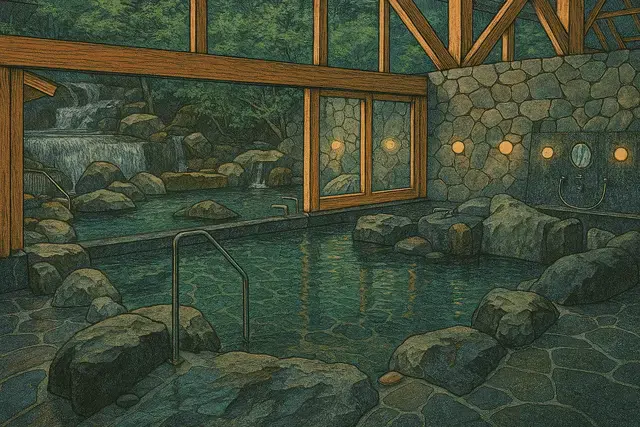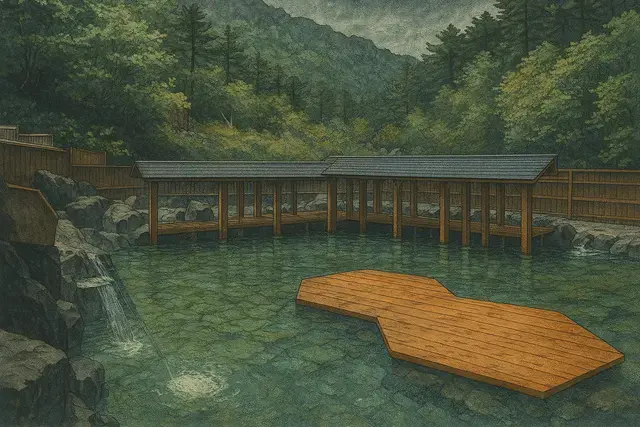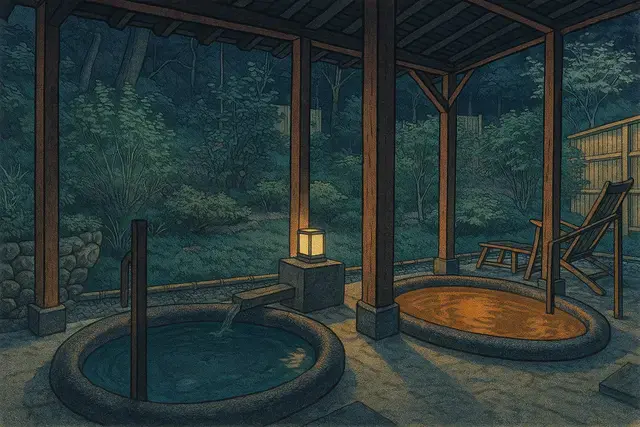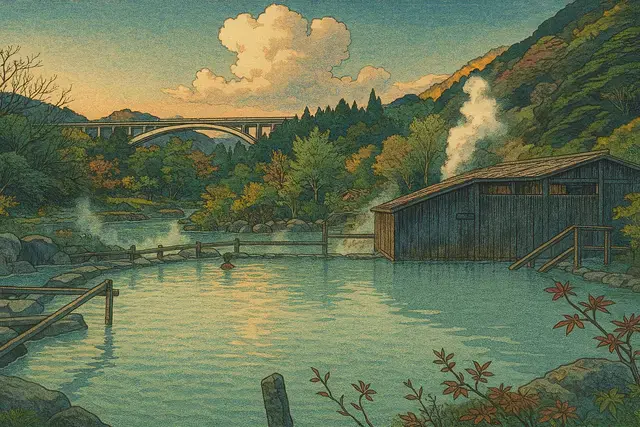The 4 Japanese Onsen Towns Every Tattooed Traveler Should Know

Top 4 Onsen Towns in Japan Where Tattoos Are Fully Welcomed
Planning to visit an onsen in Japan but worried your tattoos might get you turned away? Been there. That sinking feeling when you're excited about soaking in legendary hot springs, only to stress about whether you'll even make it through the door.
Here's the good news: a growing number of towns across Japan are throwing open their doors, welcoming all travelers with open arms and visible ink. This guide is your ticket to four fully tattoo-friendly destinations—places where you can soak stress-free, no cover-ups or private bath workarounds required.
Why Venture Off the Beaten Path for Onsen Towns?
Look, we get it. Your first trip to Japan feels overwhelming enough without adding "research tattoo policies" to your to-do list. Sticking to Tokyo, Kyoto, and Osaka feels safer.
But here's what you'd be missing: these four destinations offer something the main tourist trail can't—authentic hot spring culture where locals have been perfecting the art of relaxation for over a thousand years. You'll find yourself in steaming outdoor baths surrounded by mountains instead of skyscrapers, sharing genuine moments with Japanese families instead of fighting crowds for photos.
The best part? You can easily fit at least one of these towns in a 2 week itinerary (even for first time visitors to Japan).
How to Plan Your Tattoo‑Friendly Onsen Trip
How Long Should You Stay in Each Tattoo‑Friendly Onsen Town? Give yourself at least two nights in each destination. One night barely scratches the surface—you need time to experience multiple baths, explore the town, and truly unwind. Trust us, rushing defeats the whole purpose of onsen culture.
When to go? Each destination shines year-round, but winter adds magic—imagine soaking in steaming water while snow falls around you. Spring brings cherry blossoms (especially stunning in Kinosaki), while autumn paints the mountain towns in brilliant colors.
Budget expectations? Plan for ¥15,000-30,000 per night (per person) for a traditional ryokan experience, though budget options exist. The experience is worth splurging on at least once. In my early 20’s I used to pinch pennies staying at hostels and capsule hotels just so I could spend one night in a fancy ryokan (and it was worth it).
First-timer friendly? Absolutely. These destinations are actually easier to navigate than major cities, with clear English signage and staff accustomed to international visitors. Plus, smaller towns mean you can walk everywhere—no complex subway maps required.
Feeling overwhelmed by the planning? Consider booking a guided tour that handles all the logistics while ensuring you experience these destinations properly. Sometimes having an expert guide your first onsen experience removes all the cultural anxiety and lets you focus on enjoying it.
Tattoo‑Friendly Onsen in Kinosaki, Hyōgo

The seven-bath pilgrimage that welcomes all ink
Why Kinosaki Belongs on Your Tattoo‑Friendly Shortlist
Kinosaki Onsen is a rare gem where all seven historic public bathhouses openly welcome tattoos of all sizes, no restrictions or cover-ups needed. This traditional onsen town offers something you won't find anywhere else: the freedom to bath-hop between seven different hot springs in your yukata, wooden geta clicking on cobblestones, just like locals have done for over 1,300 years.
The town feels like stepping into a living postcard—willow-lined canals, traditional architecture, and that magical moment when evening lanterns reflect in the water. It's intimate enough to explore on foot, yet offers enough variety to keep you discovering new corners over several days.
Where to Stay in Kinosaki
Kinosaki is all about the traditional ryokan experience—this is where you want to splurge on authentic Japanese hospitality. Look for historic properties with private outdoor baths and multi-course kaiseki dining. After a day of bath-hopping in your yukata, returning to tatami rooms where dinner is served in your private space feels like stepping into old Japan. Many ryokan here have been family-run for generations, and their personal touches—from hand-written welcome notes to owners who remember your preferences—transform a good trip into an unforgettable one.
Check out our favorite tattoo-friendly onsen in Kinosaki.
Bath‑Hopping Kinosaki's Seven Tattoo‑Friendly Onsen
Each of Kinosaki's seven public onsen has its own personality. Sato-no-yu offers expansive outdoor soaking with mountain views, while Goshono-yu features beautiful traditional woodwork. Your yukata and wooden geta are your passport between them all—grab the "yumepa" bath pass and make it a proper pilgrimage.
Onsen etiquette is simple: rinse thoroughly before entering, keep your small towel out of the water, and embrace the meditative quiet. You're participating in something sacred.
Getting to Kinosaki from Kyoto, Osaka & Tokyo
The journey is half the adventure. Take the JR Limited Express "Kounotori" from Kyoto (2.5 hours) or Osaka (3 hours)—watch Japan's countryside unfold outside your window. Consider the regional JR Pass if you're exploring multiple destinations; it pays for itself quickly.
Pro tip: The train ride through rural Hyōgo is stunning, especially during cherry blossom season or autumn. Don't just endure the travel time—enjoy it.
Things to Do in Kinosaki Beyond the Baths
Ride the Kinosaki Ropeway to Mount Daishi's summit for panoramic views, especially magical at sunset. Visit the Oriental White Stork Park—these magnificent birds were reintroduced here after near-extinction. Stroll the historic district's sake breweries and craft shops, or simply follow the canal paths where locals have walked for generations.
Seasonal highlights: Cherry blossoms transform the town in April, while winter's snow creates an ethereal wonderland perfect for outdoor soaking.
Tattoo‑Friendly Onsen in Kusatsu, Gunma

Mountain hot springs with legendary healing waters
Why Kusatsu's Healing Waters Welcome Tattoos
As of 2025, all three major Kusatsu Onsen baths officially welcome tattoos—Sainokawara Rotenburo, Otaki no yu, and Goza no yu. Kusatsu isn't just tattoo-friendly; it's legendary. This mountain town claims some of Japan's most potent healing waters, so acidic they naturally sterilize themselves.
The town center revolves around the famous yubatake (hot water field)—a wooden cascade where 4,000 liters of hot spring water flow every minute. It's hypnotic to watch, especially when illuminated at night, and creates a mystical atmosphere that makes you understand why people have traveled here for centuries seeking healing.
Best Places to Stay in Kusatsu
For Kusatsu's mountain setting, choose accommodations with views of the famous yubatake and easy access to the public baths. The best properties here blend resort amenities with traditional onsen culture—think heated floors, cozy common areas for après-soak relaxation, and floor-to-ceiling windows showcasing the surrounding peaks. Many also offer guided access to hiking trails and seasonal activities. Since Kusatsu's appeal is the combination of healing waters and mountain air, your accommodation should capture both.
Check out our favorite tattoo-friendly ryokan in Kusatsu Onsen.
Experiencing Kusatsu's Yumomi & Giant Outdoor Rotenburo
Kusatsu's waters are famously hot and acidic—so much so that the traditional yumomi ceremony uses giant wooden paddles to cool the water naturally. At Otakinoyu, experience the traditional "awase-yu" style, bathing in pools that gradually increase in temperature from a comfortable 38°C to a steaming 46°C.
The outdoor bath at Sainokawara is massive—100 people could soak simultaneously while surrounded by mountain scenery. It's especially magical in winter when snow contrasts with the steaming water.
Getting to Kusatsu by Bus or Train + Bus Combo
Take a direct highway bus from Tokyo's Shinjuku (4 hours) for the easiest route, or combine JR trains to Naganohara-Kusatsuguchi with a connecting bus. The mountain journey offers incredible views, especially in autumn when the leaves change colors.
Seasonal tip: Winter travel requires preparation, but the snowy mountain scenery makes it worthwhile. Spring through fall offers hiking opportunities in the surrounding highlands.
Hiking & Seasonal Highlights Around Kusatsu
Explore Sainokawara Park's steaming walking trails—it's like walking through a natural volcanic wonderland. Hike to Mount Shirane's crater lake (weather permitting), or simply wander the lantern-lit streets lined with traditional shops selling local specialties.
Don't miss: The yumomi demonstration shows—watch local women perform the traditional water-cooling ceremony with giant wooden paddles. It's both practical and beautiful.
Tattoo‑Friendly Onsen in Arima, Hyōgo

Japan's oldest hot spring town with legendary golden waters
Why Arima's Historic Springs Welcome Tattooed Travelers
Arima Onsen stands as one of Japan's three oldest hot spring destinations, with over 1,300 years of therapeutic bathing history. Both famous public bathhouses—Kin no Yu (Golden Bath) and Gin no Yu (Silver Bath)—fully welcome tattoos without any restrictions, making this legendary destination accessible to all travelers.
What makes Arima special isn't just its tattoo-friendly policies—it's the unique waters themselves. The iron-rich "Kinsen" springs turn a mesmerizing reddish-brown when exposed to air, while the "Ginsen" waters are naturally carbonated with tiny bubbles that cling to your skin. You're not just bathing; you're experiencing the same therapeutic waters that samurai warriors, including Toyotomi Hideyoshi, sought for healing after battle.
Best of all: Arima sits just 30 minutes from Kobe and an hour from Osaka, making it the perfect off-the-beaten-path destination that doesn't require extensive travel time.
Best Places to Stay in Arima
Arima's historic significance calls for accommodation that honors its samurai heritage. Seek out luxury ryokan with traditional architecture, private mineral-rich baths, and that deep sense of cultural immersion. The best properties here have been hosting distinguished guests for centuries—some even display artifacts from their illustrious past. You're paying for more than a room; you're experiencing the same level of hospitality that once welcomed feudal lords seeking the healing powers of these legendary waters.
Traditional Hot Spring Inns: Family-run accommodations offering genuine omotenashi hospitality, often with their own mineral-rich baths and home-style cooking.
Modern Resort Hotels: Contemporary properties combining Western comfort with Japanese onsen culture, ideal for families or those wanting familiar amenities.
Check out our favorite tattoo-friendly ryokan in Arima Onsen.
Experiencing Arima's Golden & Silver Springs
Kin no Yu (Golden Bath) features the famous iron-rich waters that oxidize to a captivating amber hue. Two temperature pools (42°C and 44°C) let you find your perfect comfort level while the mineral-rich waters work their therapeutic magic on joints and circulation.
Gin no Yu (Silver Bath) offers a completely different experience with naturally carbonated, crystal-clear waters where tiny bubbles create a gentle, effervescent sensation against your skin. The tranquil setting away from the town center provides a more meditative soaking experience.
Pro tip: Purchase the combination ticket (¥1,200) to experience both unique water types in one visit. The contrast between the two springs showcases why Arima has been celebrated for over a millennium.
Getting to Arima from Kobe, Osaka & Kyoto
From Osaka/Kyoto: Take JR to Sannomiya Station, then transfer to the direct bus to Arima Onsen (total: 90 minutes). Alternatively, take the scenic Kobe Electric Railway route via Tanigami Station.
From Kansai Airport: Airport limousine bus to Sannomiya (70 minutes), then direct bus to Arima (40 minutes).
The journey is part of the charm: The final approach winds through mountain scenery that transforms dramatically with the seasons. Consider the Kansai regional JR Pass if you're exploring multiple destinations.
Mountain Trails & Cultural Treasures Beyond the Springs
Take the Mount Rokko Ropeway for spectacular views across Kobe to Osaka Bay—especially stunning at sunset or during autumn foliage season. Explore the network of hiking trails that connect Arima to Mount Rokko's summit, or visit the historic Zuihoji Park where maple trees create a fiery canopy each November.
Don't miss: The traditional craft shops lining Arima's historic streets, where you can find handmade bamboo goods and local specialties. The town's compact size makes everything walkable, creating an intimate mountain village atmosphere.
Seasonal highlights: Cherry blossoms in April transform the mountain setting into a pink wonderland, while autumn brings some of Kansai's most spectacular fall colors to the surrounding peaks.
Tattoo‑Friendly Onsen in Beppu, Ōita

Japan's hot spring capital with 100+ tattoo-friendly options
Why Beppu Is Japan's Hot‑Spring Capital for Inked Travelers
Beppu is a tattooed traveler's paradise, with over 100 tattoo-friendly onsen as of 2025—more variety than anywhere else in Japan. This isn't just about quantity; it's about experiencing every type of hot spring imaginable. Sand baths where you're buried in naturally heated volcanic sand, mud baths, steam rooms, and traditional pools ranging from crystal clear to mineral-rich blue.
Beppu feels alive with geothermal energy. Steam rises from manholes, hot springs bubble in parks, and the whole city feels like nature's own spa. It's also incredibly welcoming—this international hot spring city has been greeting foreign visitors for decades.
Best Places to Stay in Beppu
Beppu's appeal is variety, so choose accommodations that give you access to multiple onsen types. Look for traditional hot spring hotels with diverse on-site baths—sand, mud, mineral-rich pools—all under one roof. The best properties here act as your base camp for onsen exploration, often providing shuttle services to famous baths around the city and detailed maps of the tattoo-friendly options. Since Beppu specializes in therapeutic bathing, your hotel should feel like part of the healing experience, not just a place to sleep.
Traditional Hot Spring Hotels: Classic accommodations where the onsen experience is central, often featuring multiple bath types and local kaiseki cuisine.
Modern City Hotels: Contemporary comfort in downtown Beppu, ideal for exploring the city's diverse hot spring scene on foot.
Check out our favorite tattoo-friendly onsen in Beppu.
Must‑Try Baths: Sand, Mud & Cobalt‑Blue Springs
This is where Beppu shines—incredible variety. Bury yourself in hot sand at Takegawara Onsen (over 100 years old), soak in the cobalt-blue waters of Shibaseki's hilltop retreat, or try the famous mud baths that leave your skin incredibly soft. Many baths stay open late, perfect for evening onsen hopping.
Don't miss: The unique "sand bath" experience—you're buried in naturally heated sand for 10-15 minutes. It's surprisingly relaxing and great for circulation.
Getting to Beppu via Air or JR Sonic Train
Fly directly into Ōita Airport (1.5 hours from Tokyo), then a short bus ride to the city. Alternatively, take the JR Limited Express "Sonic" from Hakata/Fukuoka (under 2 hours)—the train journey along Kyūshū's coast is spectacular.
Regional transport: Beppu's compact size and excellent bus network make hot spring hopping easy. Many accommodations offer shuttle services to major bath areas.
What to See Around Beppu's "Hells" & Coastal Views
Tour the famous "Jigoku" (Hell) hot springs—colorful, bubbling displays of nature's geothermal power that you can't bathe in but are mesmerizing to witness. Take the Mount Tsurumi Ropeway for incredible views across Beppu Bay, or explore Beppu's surprising art scene in converted onsen buildings.
Seasonal highlights: The city's famous Christmas illuminations reflect beautifully in the steamy air, while spring brings incredible mountain wildflowers visible from the ropeway.
First‑Timer FAQ: Tattoo‑Friendly Onsen Etiquette & Practical Tips
What If Onsen Policies Change Between Now and My Visit? These destinations have established themselves as consistently tattoo-welcoming, but it's always wise to check current policies. Our onsen destination guides (Kinosaki, Kusatsu, Beppu, Arima) are updated regularly with the latest information.
How Do I Research Tattoo Policies Beforehand? Look for clear "tattoo OK" signage (タトゥーOK) or ask your accommodation to confirm policies before you arrive. Staff at tattoo-friendly establishments are usually proud to welcome international guests.
What's Proper Onsen Etiquette for First-Timers? The basics: wash thoroughly at the sitting stations before entering any bath, keep your small towel out of the water, maintain a peaceful atmosphere, and respect others' space. You're participating in a centuries-old tradition.
Should I Be Worried About Cultural Mistakes? These destinations are accustomed to international visitors. As long as you follow basic etiquette and show respect for the tradition, you'll be welcomed warmly. Most staff are understanding and helpful with first-time visitors.
Ready to Book Your Tattoo‑Friendly Onsen Adventure?
These four destinations aren't just exceptions to Japan's tattoo policies—they're leading a cultural shift toward welcoming all travelers. You're not just getting a hot spring experience; you're getting authentic Japan away from the tourist masses, where natural beauty meets centuries of hospitality tradition.
The journey is part of the reward. Yes, it takes a few extra hours to reach these places from Tokyo or Osaka. But that train ride through Japanese countryside, that moment when you step off the platform into a town where time moves differently—that's when you realize you've found something special. Kinosaki and Arima are particularly accessible from Osaka/Kyoto and will easily fit into a 2 week itinerary, while Kusatsu and Beppu will take you further off the standard path.
Feeling Overwhelmed? Check out these guided tours that include an overnight stay in a ryokan in Hakone (with a private onsen bath access). Leave it to the travel experts to handle all the logistics while ensuring you experience these destinations properly. Sometimes having a knowledgeable guide transforms a good trip into an unforgettable one.
Ready to dive deeper? Each destination deserves its own detailed research. Check our comprehensive guides for Kinosaki, Kusatsu Onsen, Beppu, and Arima for specific accommodations, detailed bath information, and insider tips.
The water's warm, the welcome is genuine, and your perfect hot spring adventure is waiting. You've got this.
Explore 150+ onsen with tattoo-friendly policies.
